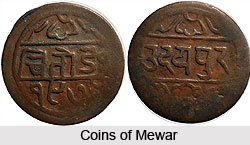 Historical evidences have established that Mewar in Rajasthan had been issuing coins since the early age. The early rulers of Mewar had, perhaps, issued some Indo-Sassanian and `gadhiya` type coins.
Historical evidences have established that Mewar in Rajasthan had been issuing coins since the early age. The early rulers of Mewar had, perhaps, issued some Indo-Sassanian and `gadhiya` type coins.
The coins that definitely attributed to the Mewar rules date back to the beginning of the fifteenth century A.D. These coins were made of copper and earlier of them were issued by Rana Kumbha. The coins were of square shape and bore the Nagari legends. These coins were issued in a number of denominations. Some bigger coins issued in this period had `Sri Kumbhalameru Maharana Sri Kumbhakarnasya` in Nagari on one side and `Sri Ekalinga Prasadat` and the date in the Vikrama era in the same script on the other side of the coin. Apart from these coins, some smaller coins were also issued and these smaller issues bore either `Sri Kumbhalameru` on one side and `Rana Kumbhakarna` on the other or `Kumbhakarna` on one side and `Ekalinga` on the other side of coin.
The coins of Sangrama Singh or Rana Sanga of Malwa imitated the Sultans of Malwa and placed `Sultan bin Sultan` in Persian on one side and his name Rana Sangrama Singh and the date in Nagari on the other side. This type of coins was followed by the succeeding rulers.
This article is a stub. You can enrich by adding more information to it. Send your Write Up to content@indianetzone.com






































